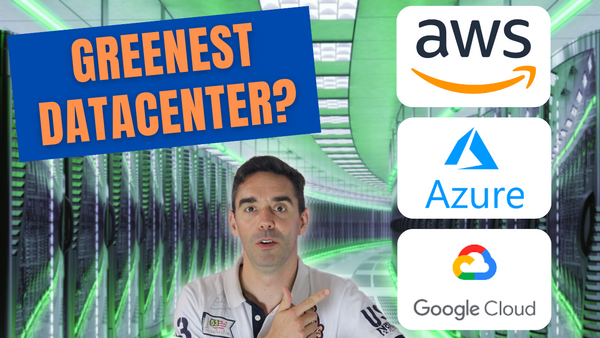When we think about sustainability, it usually comes from pollution from coal mining factories or large industrial complexes emitting dark smoke. But in the 21st century, where everything is moving to digital, the new modern factory is in the cloud. However, that digital cloud is not floating in the sky. It's made of thousands of concrete buildings, the datacenters, housing millions of computers, the physical servers. That's what's powering all our digital entertainment, online shopping, and most of the business applications we use every day.
What is the true impact of digital transformation on the environment?
When we work in digital and build applications in the cloud, how can we select the most eco-friendly solutions? How can we support our customers who are trying to make ethical buying decisions?
In this article, I'll share with you some recommendations on how to minimize your carbon footprint when working with the cloud. We will compare hosting providers and look at their green credentials. At the end of the article, we'll see that there are more considerations you should take in your digital team. Let's get to it.
First of all, we have to accept that digital transformation is usually a net positive for the environment. For example, when we build applications to process digital records, instead of paper forms manually, or when we use pay-as-you go resources in the cloud, it's much more efficient than keeping your own servers running.
However, research from the Shift Project looked at nearly 170 international studies on the environment and the impact of digital technologies. According to experts, the share of global CO2 emissions increased from 2.5 to 3.7% in the last 10 years. This means that our use of digital technologies is actually close to 4% of the global CO2 emission, which is a bigger carbon footprint than the entire aviation industry. When you have to decide where to host your next web application or digital platform, you're probably gonna go with one of the big three: Microsoft Azure, Amazon AWS, or Google Cloud... they account for nearly three-quarters of the market share and they're the most reliable technically, so let's focus on those three.
To look at their green and sustainability credentials, the three common metrics to consider are:
- The efficiency of the datacenters and infrastructure - such as the cooling system.
- The efficiency of the servers themselves.
- The source of electricity.
At the infrastructure level, the main metric is the "power usage effectiveness" or PUE which measures the total energy needed to power the datacenter versus the need for computing power.
Are datacenters powered by renewables?
If we focus specifically on the source of power for those data center and look at renewable energy, according to my research (and what those providers are publishing online), it's getting very confusing.
They are all claiming that their "datacenters are being powered 100% by renewables", but it's not very clear and it's not very accurate. Depending on the locations of those datacenters, they're still being connected to the grid that is using fossil fuels. In reality, only a fraction of each company's energy comes directly from wind installations or solar farms.
They rely on "guarantees of origin" in Europe or "renewable energy credits" in the USA to buy carbon offsets, to offset what they're consuming, to offset their emissions.
When we look at those three providers, we can see that Google's greenhouse gas emissions in 2021 are 1.5 mega-tonnes, and they commit to being carbon-free by 2030, with a PUE of 1.1 TTM. Azure has 16 MT on emissions, carbon neutral by 2030, and PUE at 1.17. Finally, AWS was a bit more difficult to gather, 44 MT of emissions, carbon net-zero by 2040 and a PUE under 1.2, we don't have the exact number.
Google Cloud hosting sustainability credentials
Google seems to be open and transparent about all those data and its green efforts. If I had to pick one, Google Cloud would have a slight edge with their datacenter in Iowa US-Central or in Europe-North in Finland being top on the list of their most carbon-free datacenters as shown on this graph.
MS Azure sustainability credentials
For Azure, they don't share the same metrics and from their infrastructure map, it seems like Europe-North in Ireland and East-US2 seems to be the only data centers with the zero-waste certified and the Microsoft Circular Center Certificate available.
AWS sustainability credentials
Finally for AWS, which owns more than a third of the market, they recommend us to "choose the region near Amazon's renewable energy project and regions where the grid has a published carbon intensity that is lower than other locations". So again, it's not really clear, it's quite hard to map directly the impact of their green efforts to their actual datacenter locations. That's the main provider we use and when we have to select the location for new clients, we prioritise probably EU-West 1 in Ireland for EU customers and US-East in North Virginia for US customers, they seem to be the closest match.
It's really hard to understand and compare those big numbers. Those credits offsetting their emission can be seen as a bit of a marketing gimmick.
Other factors to considers for a sustainable web
This is why I think there are many other factors to consider: the main one, and where we have more control over as digital workers, is the need to make more efforts on how we use those cloud resources.
It comes down to us, the technical architects or the senior developers to optimise our web application to run on the right infrastructure and to minimize the number of resources needed. All providers now have a carbon footprint calculator to help us see the impact of our services, such as this one from my AWS account, where you can see your emissions by services and can point you to areas to optimise.
The other point is also on the performance of your code, such as the number of database requests or the frontend libraries that you use, and how you optimise the videos. All of that will make the page and the site heavier to load, requiring more bandwidth to serve the content to your users.
If you're considering upgrading your current platform to be more sustainable, leave me some comments below or just get in touch. Don't forget to subscribe to my YouTube channel and follow me on Twitter to keep learning with me and grow your career in digital.
Until next time, stay safe and see you soon.



